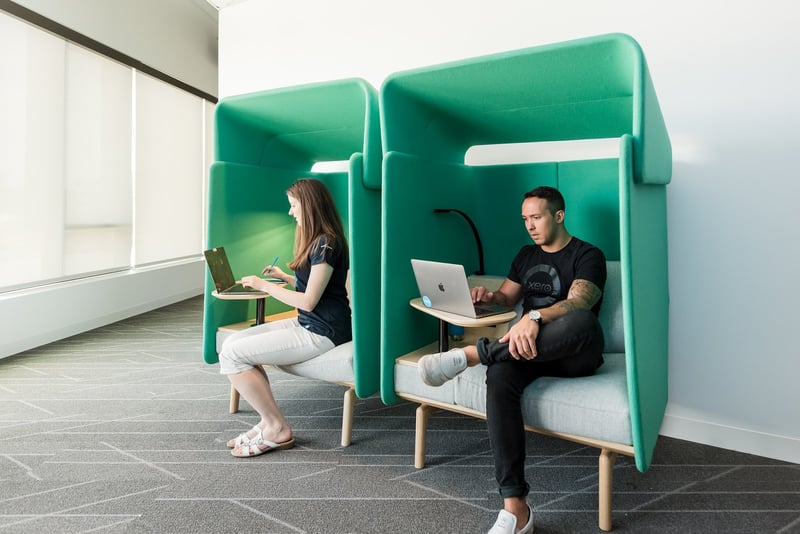Episode 2 - Employer Branding

TONY: Can you tell us a bit about yourself, your employer branding business Digital Affair, and how you got where you are today Tim?
TIM: Part of it is timing. Employer branding has become extremely popular and organisations have started to understand how important it is, both to engage their people but also to connect with customers. It’s not just isolated to the employer space. Employer branding can have a big impact on consumer brands too.
It’s an exciting space to be in but we find – because it is a new space – there’s not a huge amount of capability in the industry.
TONY: Today, we are going to talk about the importance of branding in recruitment. Why is branding so important?
TIM: I think employer branding, in particular, is incredibly important now because – especially in our industry, HR – it is the future of recruitment and your employer brand is going to become much more important than, say, your recruitment team. Your brand will be what attracts talent in the future and keeps talent within your organisation. I think it’s popular now because organisations are really starting to understand that and what the benefits might be.
RUBY: Do people come to you with an idea of what they think their brand should look like? Or is it a blank slate?
TIM: Typically, an organisation will come to us and say, ‘This is where we think we are with our employer brand and this is what we want to do’. Interestingly, the first thing we do with most organisations is work out whether that is the case or not.
A lot of people think, for example, we need to build a website because we are missing that digital asset and that will solve all our recruitment problems. Then we go into an organisation and that may not be the case. The first thing with recruitment branding is they need to figure out what they actually need to do. There’s no industry template or norm as to how you approach it. It depends on your capabilities or how you are resourced, and where your organisation is at in its own evolution.
RUBY: What are some of the most reasons why you would have clients come to you?
TIM: The most common reason would be a reason to develop that core message. What is our employer value proposition? What does it mean to work for this organisation? How do we articulate that? A lot of the time organisations know what it feels like and have a sense of what it means to be part of that employer but they’ve never condensed it and worked out what it means in words. A lot of the time the need is for that.
The other big need is to better understand the type of talent they are trying to attract into their business. They may know what they want to say about their business, why it’s a great place to work, and why other people would want to come there – but they need to understand then, what it is that the people they are looking for want to hear. Do they offer the type of work environment and rewards those people are looking for? So, the two big needs are ‘help us define our story’ and ‘help us understand who needs to hear that story’.
TONY: How has employer branding evolved over the last 10 years?
TIM: When employer branding first came around, we thought of it as something separate to the consumer brand. It’s a brand message that’s for people within the organisation and these other people we are trying to attract. In the last 10 years, we have all started to learn and realise – especially for large organisations your Telstra’s, Ikea’s – that the person we believe we want to work for us is also our customer, in many cases. So it makes no sense to have separate brand messages because it’s the same person.
The biggest change we have seen in employer branding in the last 10 years is that coming back together of the brands and recognising it’s not something that separate. You just tweak the story slightly whether you’re aiming to talk to one of your customers, or to a candidate.
RUBY: What are some of the metrics around employer branding?
TIM: One of the really exciting things for me is that employer branding is quantifiable and you can measure what your investment has achieved for you. From understanding how an audience is engaging with your brand externally, right through to tangible outcomes like – Did I reduce my advertising spend and recruitment agency spend? Have I increased engagement? Have I increased retention? Are my people performing to a higher standard? If I can prove those things, I can also map back to when I engaged them and got them involved in my brand and into the business.
The beautiful thing about HR is that we have been sitting on really valuable and important people metrics for a long time. Now we are able to understand what they really mean and what they show is what the impact of employer branding does for an organisation. I think because we are able to demonstrate that aligns with why we are seeing business leaders understanding what financial impact HR and employer branding can have on an organisation.
RUBY: Tony, when you were looking at growing the Weploy team, how much of your thinking went into employer branding?
TONY: Tim and I had a conversation in the early stages of Weploy, when we only had three people on the team. Tim basically said: This is what employer branding is and this is what it can do. So basically when we built Weploy – instead of building an employer brand and a market brand – we consciously built one brand that speaks to and has a more down-to-earth conversation style.
We’ve been really open about what our culture is like here and what we do. We’ve built a brand that people really enjoy and, through that, we have a waitlist of 10,000 Weployees to join our community, and that’s been pretty organic. When we look back at that, a lot of that came down to employer branding.
TONY: Where do you see technology playing into employer branding?
TIM: I think technology is incredibly important and is having the biggest impact on our industry at the moment. At a high level, in our part of HR, you have recruitment and employer branding, and at the moment, they are quite separate things.
I see technology – and this is 100 percent happening right now all around the world – completely automating the recruitment process. Obviously, to begin with, that’s going to be for fairly low skilled and high volume roles. However, as the technology gets better – with facial recognition in video interviewing through to the big data we can utilise and everything in-between – we are going to see all recruitment automated. Even through to high-level executives and complex technical roles. Yes, there will be an element of human interaction in some of that, but most of it is going to be automated.
So if the process you’ve usually had becomes fully automated and technology is taking care of that, you’ll see that recruitment actually becomes more about employer branding and what people say about you. It’ll become more about the attraction than it will about the onboarding process of bringing somebody into your organisation once they have expressed an interest. So, in a sense, technology is wiping out half of the industry in the way that it currently operates and will change it into something else.
Technology is really making employer branding more important. It gives you more resources and time to do employer branding because you are not screening 900 people for one job and wasting your time. The big fact that I get hung up on the most is that the typical recruiter spends most of their time not hiring people, but their job is to hire people! Technology is going to change that. It will enable HR to meet and talk to people that are probably what they are looking for and who are ready to be hired, as opposed to the masses that are not ready to be part of an organisation.
RUBY: I couldn’t agree more! What are your three tips today for getting started on employer branding?
TIM: First, make someone responsible for it. It’s got to be driven by one person in the organisation. My personal preference and belief are that comes from the top-down. The ideal situation for me would be - gaining the endorsement of the leader of the organisation first. Then you want to be working with the Heads of HR and Head of Marketing. You want the person who is responsible for the people comprehending the importance of it, and the person who’s best at telling stories comprehending the importance of it too, so that those two can work together on the communication of your employer brand.
Second, understand where your organisation is heading in the future. Look at the type of talent you’re going to need and learn about that talent as much as you can. So that whatever it is you are developing as a process or employer brand is really well matched to the type of person that you are looking for.
The third is to look at how you are resourced and what your capability is and what you are able to do. Prioritising employer branding is broad. It’s everything from social media to referral programs to systems and processes to the training of people. You can’t do all of those things with one person, so prioritise what the most important employer branding activity you can be doing right now is for your biggest return on investment.
Learn more about how Weploy works with clients and candidates and why we’re part of the new school of recruitment.

TONY: Can you tell us a bit about yourself and your work Ruby?
RUBY: I had years and years of corporate experience and I got to that purpose point, where I was like – why am I doing this? Why am I recruiting these roles constantly for businesses that I only kind of believe in?

TONY: We’ve grown our team substantially at Weploy, from three to 25, and culture is starting to become a big topic. As the senior leadership team, we are trying to figure out what kind of culture we want. Can we influence that? Or is that organic? I’d love to know, what does culture mean to you?

What challenges is Xero facing in talent acquisition?
The Team Xero value proposition to the candidate market is a strong one: we believe that you can come and do the best work of your life at Xero. And you can do so at a business that:
- Is one of the fastest growing SaaS companies in the world
- Is purpose-driven and committed to having an impact on the lives of our customers
- Has a set of meaningful values that underpin everything we do
- Is always looking to the future, questioning how we can continue to innovate to best serve our customers and stay ahead of the curve.
One of the hurdles we face, which is actually more of an opportunity, is making sure we are truly capitalising on the above messaging and amplifying it to our target candidate markets.
Whilst we have a strong value proposition – very helpful for any inhouse talent team – we also have our challenges too, primarily around scale. In a relatively short period of time, we’ve evolved from a beautiful accounting software start-up to a global small business platform. In the process, we’ve acquired a rapidly expanding customer base and built a geographically dispersed workforce of 2,500 employees. There will always be competing interests in a hyper-growth environment, so one of the main challenges for our our Talent Experience team relates to prioritisation of our hiring. Have we nailed that yet? No, but it’s something we’re continuing to work on in conjunction with Xero’s leaders.

How does tech support the recruitment process for you at Xero?
We use a range of tools and technologies to aid our recruitment process here at Xero (there are some variances by region). As we continue to evolve our TX function, we’ll keep reviewing both existing and new tech to best support our efforts across employer branding and attraction, assessment, background checking, on-boarding and talent pooling. We also consider how tech can help us work best with candidates, hiring managers and each other.
While tech is the ultimate enabler, we believe it will always remain human interactions that drive the best outcomes.
What are you doing to promote diversity within what is stereotypically a male dominated industry?
From a gender diversity perspective, we work with some amazing partners like Work 180, Code Like a Girl, Tech Girls Movement, Girl Geek Dinners and Ladies that UX to showcase working life at Xero and highlight the opportunities for women in technology. In addition to our internal programs (part-time developer programs, career change programs etc.), these partnerships have achieved some fantastic results for our workforce composition and the communities that we support.
We also recognise that gender is only one element of diversity. Indeed, our hiring practices, ways of working, internal education and workshops and external partnership development need to reflect the diversity of our 1.8 million subscribers. We will continue to value and embrace diverse experience, skills and perspectives so that we can work better together and continue to innovate for our customers, partners, and the communities we interact with every day.
How does Xero's Talent team work with hiring managers when hiring?
We view hiring as a partnership between hiring managers and the TX team. In our opinion, the key to a good hiring outcome is complete clarity on the position, the candidate requirements and the hiring process itself. We also encourage hiring managers to constantly be out there meeting good candidates in-market and thinking about succession planning for their teams (whether they’re hiring for a vacancy or not).
What aspects of working at Xero do you highlight to a candidate during the recruitment process?
We make a conscious effort to lay all of our cards on the table. Nobody likes finding skeletons in the closet when joining a new business, so we go out of our way to be really transparent about both the benefits and the challenges of working at Xero. Naturally, some of the challenges don’t align well with everyone: Working at Xero is fast paced, constantly changing and requires working with ambiguity, and we call that out throughout the recruitment process. But for those who are up for the challenge and bring a growth mindset and bias for results, the opportunities are second to none when it comes to working with amazing people, evolving team Xero capabilities, and solving problems that have a positive impact on the lives of our customers across the globe.
Streamline your hiring
Business support staff with no hidden fees. Start hiring anytime.
